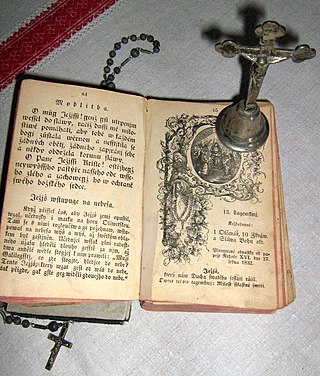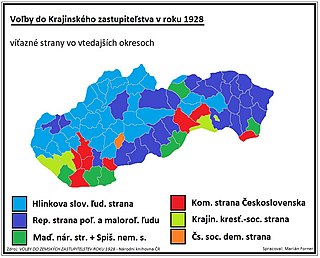
The Slovak Super Liga is the top level football league in Slovakia, currently known as the Fortuna Liga due to a sponsorship arrangement. It was formed in 1993 following the dissolution of Czechoslovakia. The record for most titles is eleven, held by Slovan Bratislava, who are the current title holders.

The Principality of Nitra, also known as the Duchy of Nitra, was a West Slavic polity encompassing a group of settlements that developed in the 9th century around Nitra in present-day Slovakia. Its history remains uncertain because of a lack of contemporary sources. The territory's status is subject to scholarly debate; some modern historians describe it as an independent polity that was annexed either around 833 or 870 by the Principality of Moravia, while others say that it was under influence of the neighbouring West Slavs from Moravia from its inception.

Štefan Krčméry was a Slovak poet, literary critic, historian, journalist, translator, and administrator of Matica slovenská. He was born in Mosóc and died in Pezinok.

The Slovak National Council was a Slovak political body, which was created in Vienna on September 15–16, 1848 during the Revolutions of 1848. It was led by Ľudovít Štúr, Jozef Miloslav Hurban and Michal Miloslav Hodža.

Bratislava is the capital and largest city of Slovakia. Officially, the population of the city is about 475,000; however, it is estimated to be more than 660,000 — approximately 140% of the official figures. Bratislava is in southwestern Slovakia at the foot of the Little Carpathians, occupying both banks of the River Danube and the left bank of the River Morava. Bordering Austria and Hungary, it is one of only two national capitals to border two sovereign states, the other one being Singapore.

The first known translations of parts of the Bible into Slovak dates to 15th century, although full translations, as an alternative to Bible translations into Czech, date from the year 1756.

The Slovak Uprising , Slovak Volunteer Campaigns or Slovak Revolt was an uprising of Slovaks in Western parts of Upper Hungary with the aim of equalizing Slovaks, democratizing political life and achieving social justice within the 1848–49 revolutions in the Habsburg Monarchy. It lasted from September 1848 to November 1849. In October 1848, Slovak leaders replaced their original Hungaro-federal program by Austro-federal, called for the separation of a Slovak district from the Kingdom of Hungary and for the formation of a new autonomous district within the framework of the Habsburg Monarchy.

Stanislav I Thurzo was a bishop of the Diocese of Olomouc. Although a Catholic, he was the son of János Thurzó, a protestant Hungarian nobleman of the Thurzó family who was mayor of Kraków, and his first wife, Ursula Boehm. He was educated at Padua in theology and law and was made canon in Olomouc.
The Polish–Hungarian Chronicle or Hungarian–Polish Chronicle is a medieval chronicle which exists in two redactions in five manuscripts kept in Polish libraries, including the Zamojski Codex from the second half of the 14th century and its 15th-century copy. Its full title is Chronicle of the Hungarians Attached to and Mixed with Chronicles of the Poles, and the Life of Saint Stephen. According to the Hungarian historian György Györffy, it "contains a fair number of absurdities".

Michael was a member of the House of Árpád, a younger son of Taksony, Grand Prince of the Hungarians. Most details of his life are uncertain. Almost all kings of Hungary after 1046 descended from him.

Ladislas the Bald was a member of the House of Árpád, a grandson of Taksony, Grand Prince of the Hungarians. He is the only known brother of Vazul, a rebellious duke who was blinded on the order of their cousin, King Saint Stephen I of Hungary in 1031 or 1032. Medieval chroniclers, in their effort to conceal that the Kings of Hungary were descended from a prince condemned by the saintly first king, wrote that instead of Vazul, Ladislas was the Hungarian monarchs' forefather. Ján Steinhübel and other modern Slovak historians write that he was Duke of Nyitra under Polish suzerainty, but this theory has not been universally accepted by historians.

Parliamentary elections were held in Slovakia on 18 December 1938 following the German occupation of Czechoslovakia.
Janko Kroner is a Slovak film, television and stage actor. Once a regular cast of the Slovak National Theater (SND) (1987–2009), Kroner began his acting career as part of the New Scene (1982–86). In the mid 1990s, alongside staging for his home theater, he gradually began appearing in a local VA-based ensemble called a.ha. In the most recent decade, he has been known as the frontman of the Malá scéna STU, a body supervised by Kroner through 2010-2011.
The 13th OTO Awards, honoring the best in Slovak popular culture for the year 2012, took time and place on March 16, 2013 on the New Opera stage of the Slovak National Theater in Bratislava. The ceremony broadcast live RTVS on Jednotka, the hosts of the show were Adela Banášová and Matej "Sajfa" Cifra.

The Martin Declaration is the name usually given to the Declaration of the Slovak Nation that was proclaimed in the town of Turčiansky Svätý Martin on 30 October 1918. The declaration was effectively a declaration of independence from the Kingdom of Hungary and presaged Slovakia's unification with the Czech lands as part of the new state of Czechoslovakia.
Milan Stanislav Ďurica is a Slovak historian and theologian.

Provincial elections were held in Slovak Province on 2 December 1928. The elections were marked by a drop in support for the Slovak People's Party, whilst the Republican Party of Farmers and Peasants emerged as the largest party in the Assembly of Slovakia.

Dušan Kováč is a Slovak historian and writer. He specializes in Slovak and Central European history of the 19th and 20th centuries, the author or co-author of several synthetic works about Slovak history. The head of the Institute of History of the Slovak Academy of Sciences (1990-1998), the scientific secretary of the Presidium of the Slovak Academy of Sciences. The member of several Slovak and foreign scientific organisations like the Collegium Carolinum in Munich or the Royal Historical Society in London. He is a brother of the Slovak ex-president Michal Kováč.
A burgher was a rank or title of a privileged citizen of medieval towns in early modern Europe. Burghers formed the pool from which city officials could be drawn, and their immediate families that formed the social class of the medieval bourgeoisie.
Mikuláš Teich was a Slovak-British historian of science, best known for the series of histories in national context which he co-edited with Roy Porter. He was married to the economic historian Alice Teichova.














